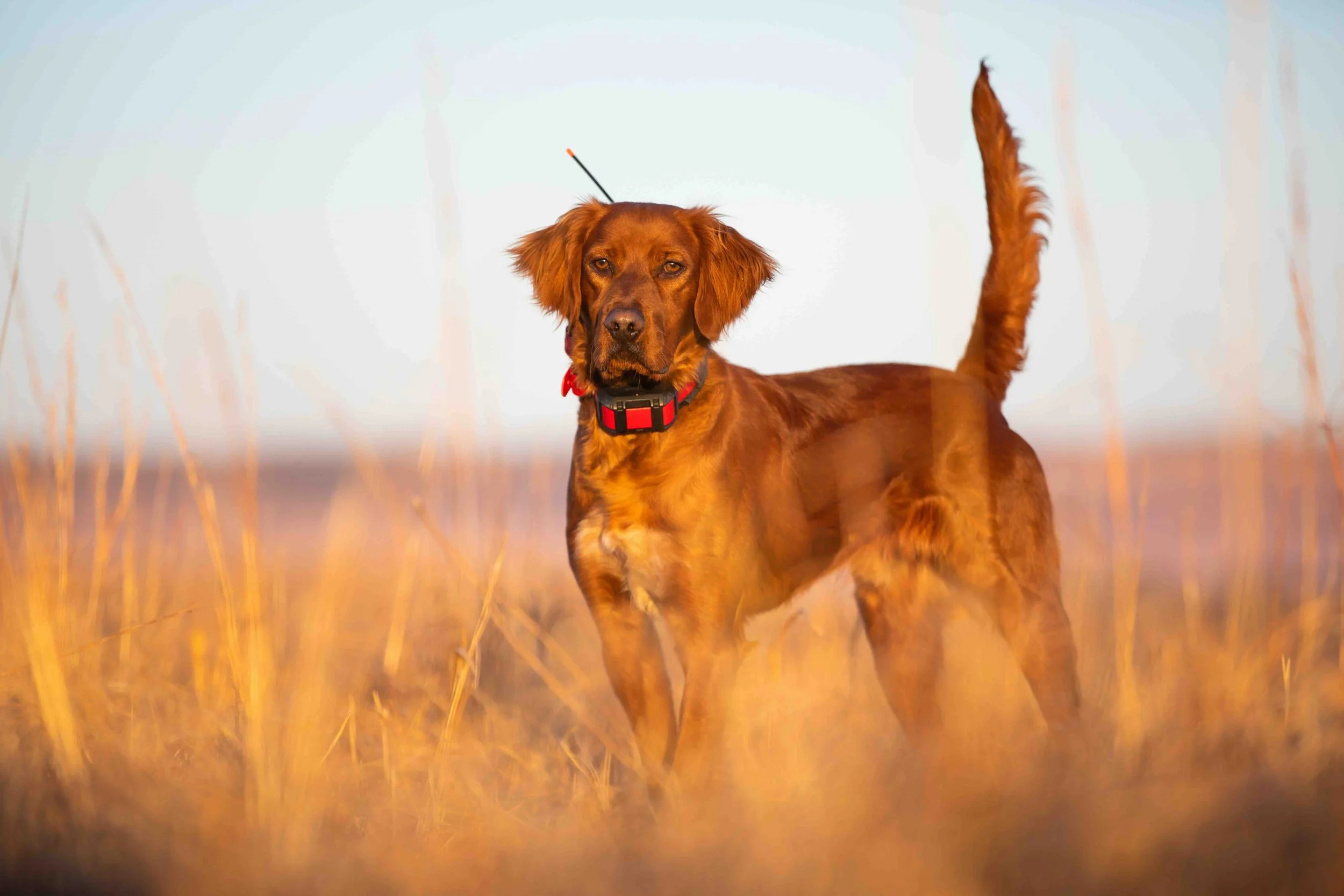E-Collar Introduction and Cues
We introduce the e-collar after cues for the desired behaviors are fully taught and the dog consistently responds to a physical cue with confidence. In our training system, all cues are introduced in the Foundation Level, which is the first level of training. The transition to the e-collar occurs during the Intermediate Level, once the dog is proficient with all of the Foundation concepts.
We prefer collars with click-incremented dials, where each level represents a consistent and measurable change in stimulation. Our gold standard for training are the Garmin 550 Pro and the Garmin 550 Pro Plus, which offers 18 levels of continuous and momentary stimulation, plus tone and vibrate options. This makes it easier to tailor the cue to your dog in real time. The unit also features simple, at-a-glance directional GPS tracking and is user-friendly—allowing handlers to stay focused on their dog during training.
Teach the Behavior First
The e-collar is simply a remote cue to ask for behavior that has already been taught. We teach the desired behavior, using a mechanical cue which is a physical connection via a rope, such as a Wonder Lead or check cord. This establishes a clear point of contact and line of communication. In a controlled setting, we first shape our Core Bird Dog Behaviors, such as heel, whoa, and recall, building responsiveness to cues and a willing, “joined up” mindset.
Once the dog performs the behavior consistently and confidently on a rope, we can overlay a low-level e-collar cue to achieve the same response remotely. The transition is smooth because the behaviors—and the context—are already familiar and routine.
Practice In Controlled Environments and then Apply in Increasingly Challenging Ones
We always begin collar introductions in a quiet, mowed area with minimal distractions and no game birds. The dog remains on a lead or check cord during this introduction. This gives us more control of the dog and better ability to guarantee their success. Simple, short sessions are also key to success.
As the dog becomes more comfortable and proficient with the cues, we are able to increase the challenge. First by incorporating our agility course. Now, for example we are able to ask them to heel off-lead over obstacles or whoa when navigating over an object. This increases the distraction level and gives more variety in what we ask of our dogs. We want to always engage the dog’s mind and not just practice monotonous repetition. Our obstacle course helps provide more engagement and variety. As proficiency increases, we increase distractions again by moving to a small fenced-in area with more natural vegetation (where a dog’s mind may shift to running and hunting). Finally we move out to the bird field to practice before introducing the concept in a bird situation. Each step builds the level of excitement and distractions, making it more challenging for the dog. The end goal is a dog that will perform in any environment.
Mindset Determines the Cue
We strive to use the most subtle cues possible to gain compliance in training. When we use our e-collar, we start very low and slowly work up to determine the level of stimulation that is just enough to gain an awareness. A slight change in pace, headset, or body language can indicate that the dog is aware of the cue. The goal is to be able to cue our dog and have them promptly comply, while generally appearing to have made the decision completely on their own.
A dog’s mindset and level of distraction determines their perception of the world and attentiveness to cues. If a dog is cued and nothing in the dog’s body changes, they may simply not be aware of the cue because of mindset and distractions. Each cue should be tailored to the dog’s mindset in that particular moment and the dog must first be aware of a cue before they can respond.
Stress or lack of confidence can magnify a dog’s perception of stimulation. People are the same way. Someone that is overly concerned about and focused on the collar may feel it on the palm of their hand on a low level 1. Whereas most people that are familiar with and comfortable using a collar, tend to not feel anything until a low level 2. Stress is an intensifier, making everyone more sensitive to any type of stimulation. By starting with a solid foundation we can build the concept incrementally and never overwhelm or overly stress our dog.
The level of distraction is also a determining factor of a dog’s mindset. If a dog is paying attention to the handler and focused on their interaction, the cues will generally be at the lowest level for that individual. When there are more distractions, it will take a higher cue to gain an awareness. And this premise holds true on all cues, not just a remote cue of the e-collar.
Gaining or maintaining our dog’s relaxed and confident mindset is a consistent goal in all of our workouts. The level of the cue, the number of repetitions, and the duration and direction the of the training sessions are all determined by the individual dog’s mindset during that workout. Our goal is to keep the dog relaxed, confident, and receptive to us and learning. Every interaction varies according to the dog’s mindset in the moment.
Introduction of Verbal Cue
At the same stage that we introduce the e-collar, we also introduce verbal cues for the behavior. Because the dog already understands and consistently performs the action, we can now easily “name” the perfected behavior with a word.

